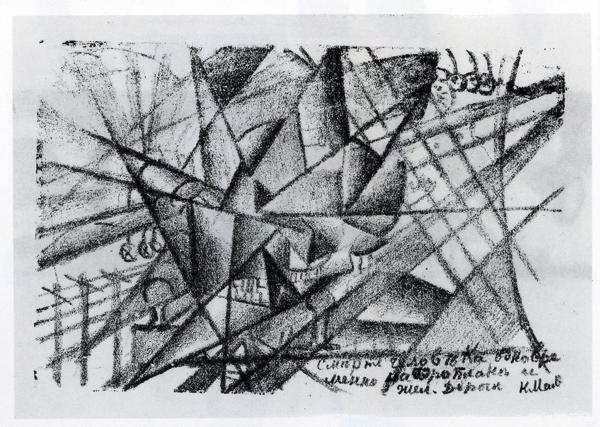Description
Kazimir Malevich is an iconic figure in the history of modern art, especially recognized for his work in suprematism, an artistic movement that he founded. However, before consolidating this radically abstract style, Malevich traveled through other artistic phases. One of these early stages is clearly represented in his work "Death of man on the plane and on the train at the same time. Illustration for - 1913". In this work, you can see the transition period of the artist between Cubism and Futurism, two movements that deeply influenced their subsequent experiments.
When observing the composition of the painting, one is immediately caught by the overlap of elements and forms that evoke a feeling of simultaneity and movement. The title alone, "Death of man on the plane and on the train at the same time," suggests a simultaneous narrative, a concept that Malevich effectively explores through the compositional disposition of the visual elements. The scene is an amalgam of mechanics, speed and tragedy, reflecting the fascination of futurism for modernity and the machine, but also the chaos that these innovations can bring.
The color palette used by Malevich is intricate and reveals its ability to handle shades that increase tension and dynamism on the scene. The dark colors combined with areas of a vibrant red predominate that capture the viewer's view immediately. These bright reds not only serve as focus points, but also intensify the feeling of urgency and uneasiness that permeates the work.
Unlike his subsequent works where he moved towards pure and abstract geometric shapes, in this painting we still see a use of recognizable, although distorted forms. The plane and the train, although represented with a cubist touch, are identifiable and articulate the conflict between the known and the abstract that defines this stage in the Malevich race. The human figure, although not clearly delineated, suggests a presence through fragmented forms, as if it were subsumed by the technological forces that surround it.
It is crucial to mention that, although this work is not suprematist in the strict sense, seeds of what would later develop in that style can be identified. Malevich's concern for a new spatial and temporal consciousness is present here, although still connected to the most traditional representation.
The "death of man on the plane and on the train at the same time" is a testimony of the exploration of Malevich at the confluence of technology and humanity, an issue that would resonate differently but persistently throughout his posterior career. As an art work, it challenges the viewer to reflect on the impact of modernity and speed on human life, issues that would remain relevant throughout the twentieth century and beyond.
This painting is a window to the restless and revolutionary mind of Kazimir Malevich in a transitory period, and invites us to study the connections and differences in its evolution towards suprematism. The complexity and richness of Malevich's work continue to be an invaluable source for the understanding of modern art and its various metamorphosis.
KUADROS ©, a famous paint on your wall.
Hand-made oil painting reproductions, with the quality of professional artists and the distinctive seal of KUADROS ©.
Art reproduction service with satisfaction guarantee. If you are not completely satisfied with the replica of your painting, we refund your money 100%.

